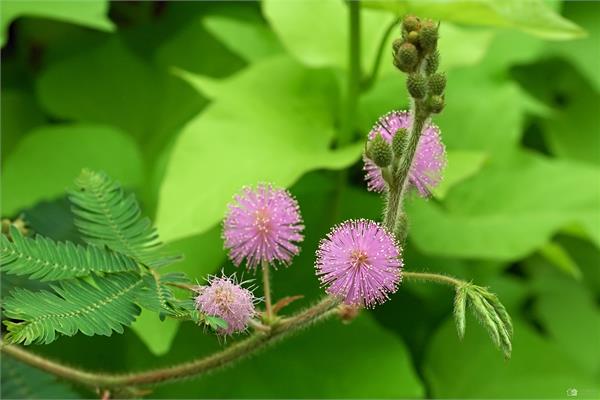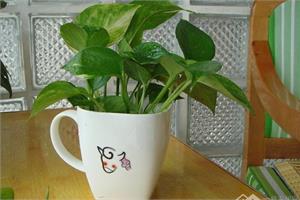How does mimosa grow? why is mimosa shy?
When stimulated (such as touching), the leaf surface of mimosa shrinks, and its combined characteristics make many flower friends like it very much. Mimosa has strong vitality and strong ability to adapt to the environment. Fertile, loose sandy loam is better, requiring the soil to be deep, fertile and moist. Next, let's take a look at how to raise mimosa. I hope it can be helpful to flower friends.

First, the basic information of mimosa
Mimosa is a perennial herb or subshrub of Leguminosae, which is named mimosa because its leaves respond to heat and light and close immediately when touched by external forces. Native to tropical South America, it likes to be warm and humid, and is not strict with the soil. The flower is pink, shaped like a fluffy ball, delightful. Pods bear fruit after flowering, and the fruit is flat and round. The leaves are feathery and compound leaves are alternate and arranged in palms. The flowers, leaves and pods of mimosa have better ornamental effect, and are easy to survive, so they are suitable for balcony, indoor potted flowers, and can also be planted in the courtyard.
Second, the characteristics of mimosa
The most important feature of mimosa is that when it is stimulated (such as touching), the leaves of mimosa will contract and come together. If the stimulus is strong, the stimulus will be quickly transmitted to the adjacent leaflets, and even to the entire compound leaflet, causing the petiole to droop. If the stimulation intensity is larger, it can even make the leaflets of the whole plant close and the compound leaves droop. But after a period of time, the original state can be restored. Mimosa also responds quickly to vibrations. It begins to respond after 0.1 seconds of stimulation and finishes in a few seconds.
Third, why the mimosa is shy
The reason why mimosa is shy is closely related to its native environment. The shy prairie comes from tropical South America, where the climate is bad and there are often high winds and torrential rains. In order to protect itself, when the first drop of Rain Water falls on the mimosa leaf, it will close the leaf promptly and effectively and hang its petiole to avoid the damage of the storm, which is the self-adjustment of the biological world.
Fourth, how to raise mimosa
1. Soil. General soil can be cultivated, but the fertile, loose sandy loam is better, which requires the soil to be deep, fertile and moist.
2. Fertilization. During the growing period, you don't need much fertilizer, you can apply dilute liquid fertilizer 2Mel 3 times, and you should not have too much fertilizer, just grow strong with leaf green, do not make it grow, because mimosa is mainly interesting foliage flowers, small is better.
3. Watering. Mimosa likes to be moist and needs to be watered frequently, once a day during the summer growing season. Shy prairie is a tropical plant, like a humid environment, so always keep the basin soil moist, watering the basin soil in summer, about once a day, do not let the soil dry, you can often spray water to the plants, and reduce the amount of water in winter to prevent freezing damage.
4. Light. Ensure plenty of sunshine, mimosa likes sunlight, it is best to put it on a sunny balcony or window, full exposure to sunlight is good for mimosa growth, if too little sunlight, it may hinder its growth.
5. to prevent diseases and insect pests, mimosa generally has few diseases and insect pests, and the most common pest is slugs. If found, you can sprinkle some lime powder for prevention and control. If the plant does not grow well, check to see if the light source is insufficient or the water is not enough.
Mimosa these special skills, people can not help but like it. If you plant such a mimosa at home, it will close its leaves when you touch it when you are unhappy. Isn't it interesting? The above is the introduction of the culture method of mimosa, if you want to know more information about mimosa, please pay attention to more wonderful content.
- Prev

Can green pineapple be put in the bedroom? matters needing attention in breeding green pineapple
Can green pineapple be put in the bedroom? matters needing attention in breeding green pineapple
- Next

What problems should be paid attention to in how to cultivate green pineapple
What problems should be paid attention to in how to cultivate green pineapple
Related
- Wuhan Hospital Iron Tree Blooming Result Was Instantly Frightened by the Gardener Master
- Which variety of camellia is the most fragrant and best? Which one do you like best?
- What is the small blue coat, the breeding methods and matters needing attention of the succulent plant
- Dormancy time and maintenance management of succulent plants during dormancy
- Minas succulent how to raise, Minas succulent plant pictures
- What are the varieties of winter succulent plants
- How to raise succulent plants in twelve rolls? let's take a look at some experience of breeding twelve rolls.
- Attention should be paid to water control for succulent plants during dormant period (winter and summer)
- Watering experience of twelve rolls of succulent plants
- Techniques for fertilizing succulent plants. An article will let you know how to fertilize succulent plants.

